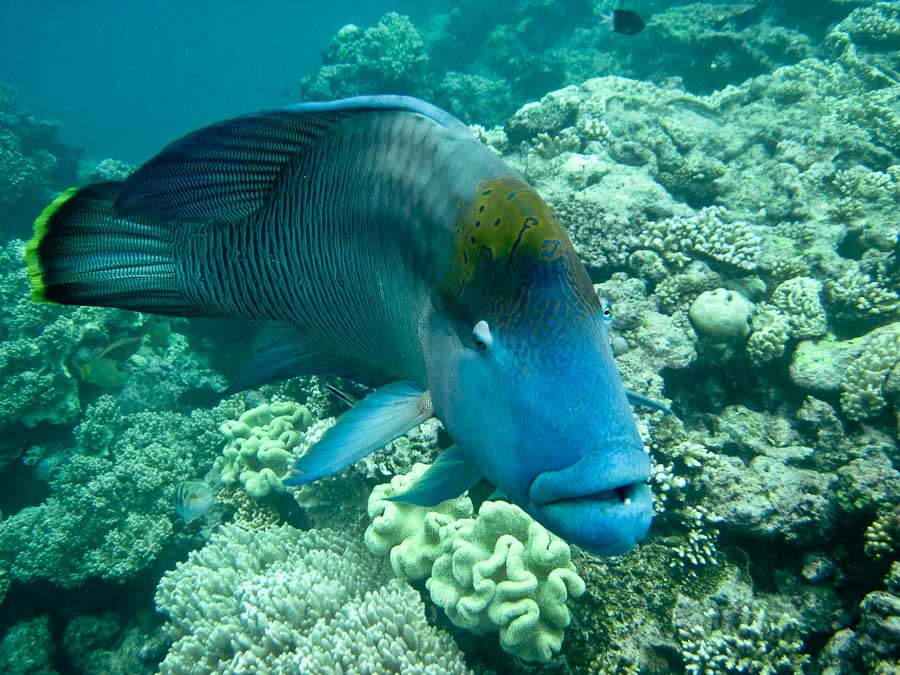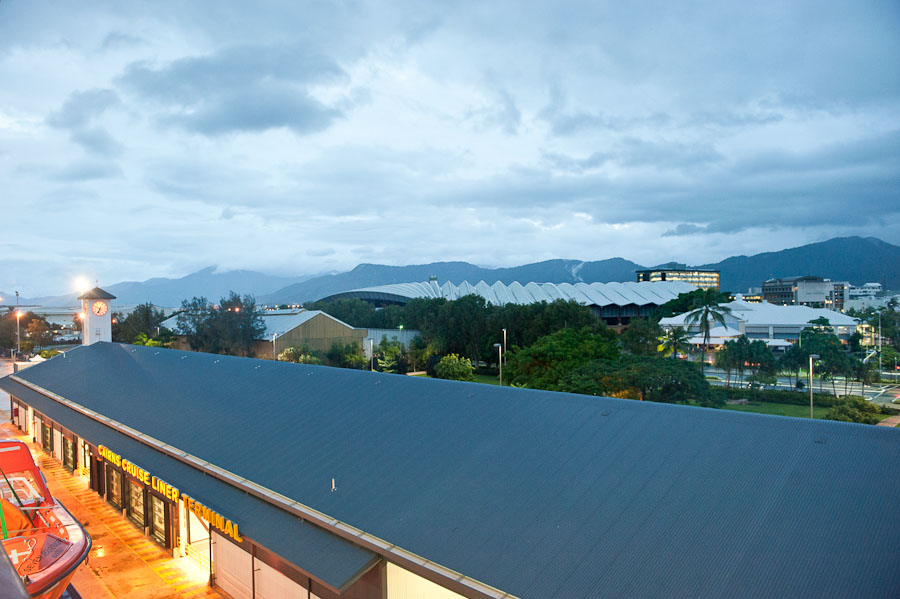We are in the middle of Great Barrier Reef country now…Cairns, Australia (the correct pronunciation is “Cans”…we’re going to make a really Aussie out of our readers yet)! Our tour today is to go out to a platform permanently floating on top of the Great Barrier Reef where we can dive, snorkel and basically have a good time at the Reef.
Click here for the detailed Photo Gallery for Cairns.
There was no bus today (yea!) and we got in line with 200 other Regent “reef” explorers to walk a mile to the high speed catamaran that would take us to the reef. Now, let’s be realistic for a moment, 200 people with an average age of 70+, walking a mile at 8 am in a strange city, is quite a sight but everyone was up for it and in record time we were all loaded up on our large motorized catamaran and settled in for the 90-minute ride. The cat was comfortable enough, but it soon became evident that the seas were getting rough and that some of us would soon be feeling the “motion of the ocean” in a way that isn’t so pleasant.
Dale and I had found a nice spot at the front of the ship that was fairly flat, but up on the back, outside area, folks were not only getting the full force of the bumps, but there were also getting wet from the ocean spray as it became worse and worse. To make matters even more difficult for those outside, we passed through a rain squall! Good times.
We finally made it to the Reef platform, not too soon for me, and they tethered the cat to the platform. The problem was, the ocean was moving the platform as well as the cat…so between the two, it was a bit of a challenge to move around on either!
Dale opted to do a certified scuba dive and I was planning on snorkeling. Once on the platform Dale made his way to the scuba group and I checked things out. The platform wasn’t that large, but it seemed to accommodate the 200 of us pretty well. There were tables set up all around the area and as soon as we got there, people were struggling to put on their lycra swim guards.
It turns out, there can be pretty significant jellyfish infestations in the water here so they recommend everyone wear a head-to-toe lycra suit. Not pretty on most of us…well basically not pretty on any of us. While Dale was on his dive, I opted to start out on a submersible boat ride.
My ride took about 20 of us out to different areas of the reef where we could see the coral and fish as we drifted by. The submersible has a room, just under the deck, that is filled with windows on both sides. This is where we sit to watch the goings-on under the ocean surface. It’s a nice way to go under water without getting wet!
Our day was rather grey, so the water and subsequent color of the fish and coral were muted…not a Great Barrier Reef day but it was still pretty darn good. I did get to see a turtle and some parrot fish which was nice.
Once back on the platform, we were served lunch and I opted to go for a snorkel off of the platform. Our friend Sherrie had been snorkeling off and on for the entire time we were there…I think she is part fish and, of course, using Dale’s Canon D10, she was constantly taking pictures of her aquatic friends.
There was a very large (several feet long) Napoleon Wrasse fish that is always hanging out around the platform they call “Wally”. Wally gets his picture taken a lot…he is really the star of the show. The staff photographer gets into the water with her scuba gear and underwater Nikon and Wally just comes up to her ready to pose with anyone. Nick and I kidded that Wally wasn’t really a fish…but a mechanical device remotely controlled by someone on the platform! Sherrie seemed to think that Wally was real, and after Dale and I saw him close up for ourselves, we tended to agree with her.
After another couple of hours of hanging out, snorkeling and drinking some beer and wine (thanks Nick!) we made our way back on-board the catamaran. The ride back was much more pleasant and flew by as we relaxed and talked to some new friends we met on board.
The weather turned out OK in the end…not great, but it only rained a few times and the sun actually came out after lunch. Below is a video of Wally!
Photography Comments:
Off and on rain throughout the day and gray skies meant we didn’t get any of the “classic” great barrier reef shots. No mind-blowing colors in the water, lots of white-out skies and the hard rain the day before stirred up the water, especially below 30 feet on the SCUBA dive. That being said, the snorkel on the reef next to the platform was really quite good! Some colorful coral formations, many colorful fish and the ever popular Wally made for some good times snorkeling. Of course, without a real underwater 35mm camera and good lighting you will never get really stunning underwater pictures but we did the best we could. At least we will have something to remember our trip out to the reef.



.jpg)



Trip Summary » Travel with Dale & Margaret - […] Cairns, Australia […]